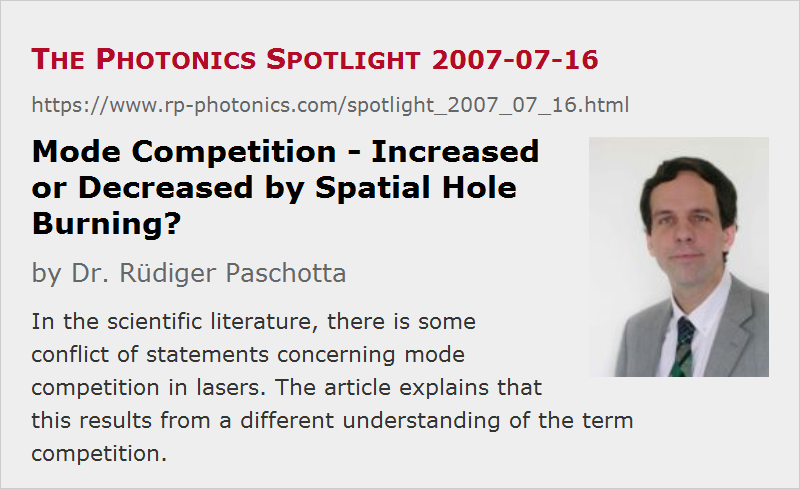Mode Competition - Increased or Decreased by Spatial Hole Burning?
Posted on 2007-07-16 as a part of the Photonics Spotlight (available as e-mail newsletter!)
Permanent link: https://www.rp-photonics.com/spotlight_2007_07_16.html
Author: Dr. Rüdiger Paschotta, RP Photonics Consulting GmbH
Abstract: In the scientific literature, there is some conflict of statements concerning mode competition in lasers. The article explains that this results from a different understanding of the term competition.

Ref.: encyclopedia articles on mode competition, spatial hole burning, resonator modes
Some research papers claim that spatial hole burning induces a competition of resonator modes in a laser resonator. But others say on the contrary that competition is reduced by spatial hole burning. I definitely favor the latter statement, and explain it in the following to lift the confusion which arises from this apparent conflict of views.
They key is to define the term “competition”. In the context of resonator modes in a laser, I would describe that as the fact that different modes share (at least partially) the same region of a pumped gain medium, and in this situation there are cross-saturation effects: each mode can saturate the gain not only for itself, but also for the other (competing) modes. This kind of competition is reduced e.g. by spatial hole burning: different modes have not completely overlapping standing-wave patterns, so that cross-saturation effects are reduced.
However, some people perceive competition as something causing unrest, and thus recognize it in lasers which are subject e.g. to spatial hole burning, exhibiting a steadily fluctuating pattern of power distribution on several (or many) resonator modes. They would then not recognize competition e.g. in a unidirectional ring laser, which exhibits stable single-frequency operation. But this stability exactly results from strongest competition in the former sense (the meaning which I prefer): the mode with highest gain is able to keep all other modes down.
This article is a posting of the Photonics Spotlight, authored by Dr. Rüdiger Paschotta. You may link to this page and cite it, because its location is permanent. See also the RP Photonics Encyclopedia.
Note that you can also receive the articles in the form of a newsletter or with an RSS feed.
Questions and Comments from Users
Here you can submit questions and comments. As far as they get accepted by the author, they will appear above this paragraph together with the author’s answer. The author will decide on acceptance based on certain criteria. Essentially, the issue must be of sufficiently broad interest.
Please do not enter personal data here; we would otherwise delete it soon. (See also our privacy declaration.) If you wish to receive personal feedback or consultancy from the author, please contact him e.g. via e-mail.
By submitting the information, you give your consent to the potential publication of your inputs on our website according to our rules. (If you later retract your consent, we will delete those inputs.) As your inputs are first reviewed by the author, they may be published with some delay.
 |




If you like this page, please share the link with your friends and colleagues, e.g. via social media:
These sharing buttons are implemented in a privacy-friendly way!